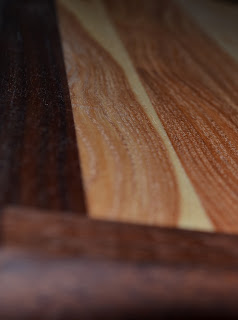 |
| Add caption |
 |
| This shows a good view of the edge grain construction. |
 |
| You can see the contrast between the pale yellow and the more colored grain. |
The boards are ringed with walnut. The dark color of the walnut creates a strong contrast with the lighter-colored ash. I routed a round-over on the walnut, defining a top and bottom to the board and giving it softer edges.
The finish is butchers block oil. There's nothing fancy or permanent about it, but it is food safe (if it weren't it would be a pretty crappy cutting board). It will fade over time, but all you need to do to refresh it is rub another coat on.
Also, if you ever desire a "fresh" surface again, you can always just sand it down, apply more oil, and voila, you've got one essentially brand new cutting board.



No comments:
Post a Comment